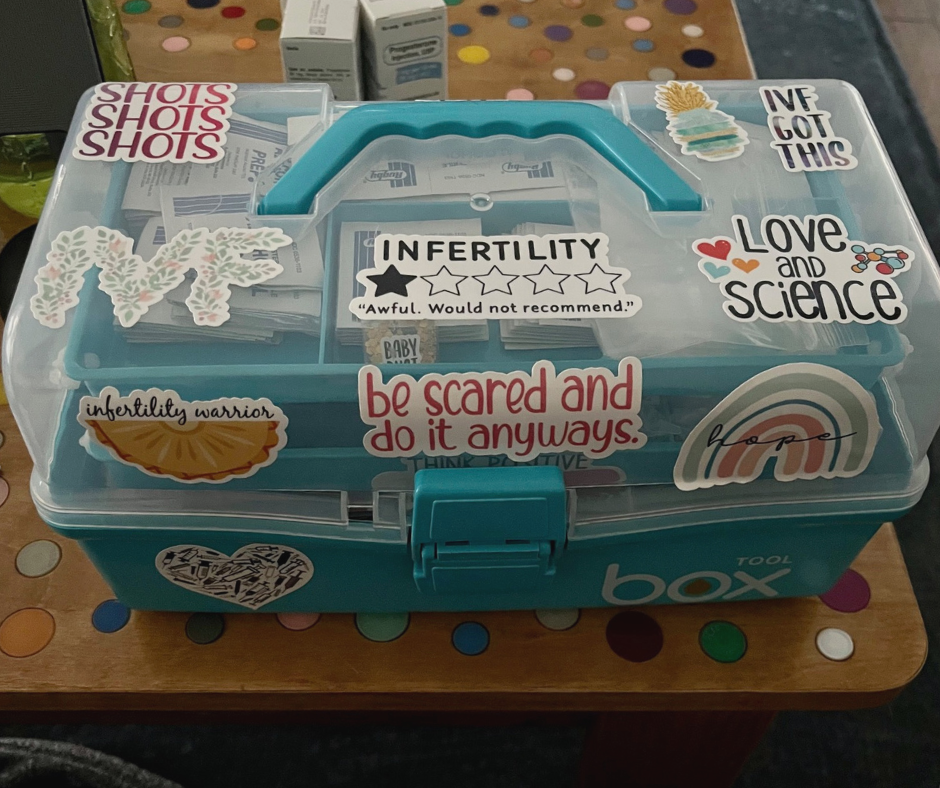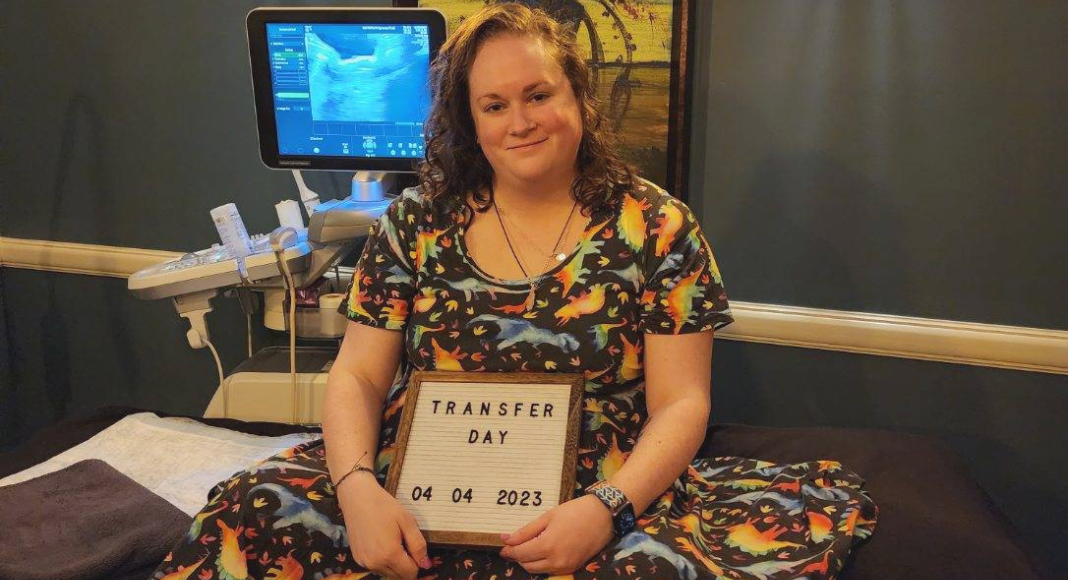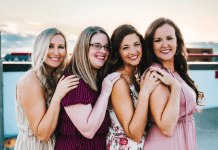In March of 2021, after 16 months of trying to conceive, I got a positive pregnancy test. I was overjoyed with the news that we were going to have a baby. We called the baby Poppy since the pregnancy app I downloaded said baby was the size of a poppy seed when we found out. We started to plan out a future including our baby.
When that pregnancy ended in an early miscarriage just a week later, we took time off from trying again to grieve our loss and process what happened. We also decided to seek out help from a reproductive specialist to check if there were any obvious problems. After about six months, we started intra-uterine insemination (IUI). I was able to get pregnant again on the second cycle.
This time I was calling the pregnancy “Maybe,” since maybe I would get to have my baby, maybe I wouldn’t. After losing Poppy, I couldn’t invest the same blind optimism that this pregnancy would be a success. Shortly after six weeks, we lost our Maybe as well, which we found out about at the ultrasound on Poppy’s would-be due date.
We ran an onslaught of tests. I changed my diet drastically, cutting out dairy, gluten, and foods fortified with folic acid after discovering a MTHFR gene mutation which could make me incapable of processing folate in that form. My husband and I both started taking a fist-full of supplements to improve our fertility. And still . . . nothing was “wrong”, but I wasn’t getting pregnant. I was shown to have a lower ovarian reserve than average for my age. And, I MIGHT have PCOS (a diagnosis which is often thrown at people who have a higher BMI and infertility when they don’t have a better explanation).
Neither of these factors seemed severe enough to my doctors to prohibit me from getting or staying pregnant. This was since my cycles are regular and my blood work indicated I was ovulating each month. After a few more rounds of IUI had failed, we had to decide what our next steps were.
I never thought we would do IVF.
How could we spend thousands of dollars (since our insurance does not cover any infertility care) on the chance to try to have a baby? We spent months debating adoption, foster care, trying more obscure and expensive tests, seeing new specialists, and of course, IVF. I just wanted to be the mother to a living child, no matter which path brought us to that result.
I was warned that IVF may not yield a high number of follicles (eggs) due to my lower ovarian reserve. We eventually decided we would have regrets if we didn’t at least try one round of IVF to see for ourselves. I was so grateful to have a specialist refer me to CNY Fertility in New York for a consult. They offer IVF services at a lower price than the national average. This made it more affordable for us paying out of pocket.
Knowing about our potential egg troubles, we decided to look into adding eggs from an anonymous donor to my IVF cycle.
I know it’s unusual to think about this on the first go. But, I had a feeling we wouldn’t have a lot of embryos to work with. I wanted to have the most chances possible to have as many embryos as possible from a single cycle. Our clinic has a wide range of egg donors with already frozen eggs. We spent the time reviewing biographies and scrutinizing family histories. We browsed baby and adult pictures of potential donors until we narrowed it down to one.
Our egg donor loves dogs, and has big brown eyes. She has a radiant smile that had shown through on her pictures. She reported having had an early miscarriage in her history along with her having living children. This drew me to her specifically. I knew that this woman could understand that what she was offering me was so precious . . . in a way I don’t think people who haven’t been through a pregnancy loss could possibly understand. She gave me options, and much needed gentle hope.
We purchased our six frozen donor eggs and got our meds ordered from the clinic.
Then, we awaited the start of my next cycle. On day one, we called our clinic. They gave us day-by-day, step-by-step instructions to start the stimulation meds on day three. The goal is to get my body to grow many eggs, instead of just the one or two a normal monthly cycle would create. The plan included two shots in my stomach per day, some oral medications, and ultrasound/blood monitoring three times per week until my follicles (eggs) looked good enough to plan for retrieval.
I gave myself some shots to prevent my body from releasing the eggs. The days before egg retrieval, I gave myself a few more shots to help the eggs mature for collection. I’m lucky enough to be a nurse, so giving myself belly shots wasn’t a big deal to me. But, there were a lot of bruises and bloating! My side effects were mild, which isn’t the case for everyone. I had heard that the more eggs are growing, the more uncomfortable it can be. My lower number of 12 total eggs of varying maturity surely made a difference.
When they determined my eggs were ready, I had about 48 hours to get to New York for my egg retrieval.
This meant finding last-minute coverage at work and hotel accommodations. My boss and co-workers made miracles happen for me to drop everything and drive to Syracuse. I went to the clinic early in the morning for retrieval. They took my vital signs, started an IV, and then the anesthesiologist and doctor came in to do their part.
I don’t remember going to sleep. I awakened in the recovery room a bit later and they told me they were able to retrieve six follicles. My donor eggs had to be thawed and fertilized as well, so our starting count was 12 eggs. We were warned that 50% or so of donor eggs may not be viable for use after thaw and that mine may not all be mature. So, we went back to the hotel to wait for our embryologists to take over.
The next morning, we got an update: three of my eggs were not mature and couldn’t be used, and two of the three mature ones had fertilized. Of my donor eggs, five out of six had survived the thaw, and four out of five had fertilized! Six embryos on day one was more than we expected. I felt so relieved that I had decided to use donor eggs on top of my own.
My husband and I chose to do a fresh transfer of the best-looking embryo in the bunch, no matter which egg source that embryo came from.
If there were remaining embryos, we chose to have them genetically tested to ensure the best odds of having a healthy living child. We purchased a few additional services to add to the transfer: acupuncture, lipid infusions, and a uterine wash of HCG (the pregnancy hormone) to give our embryo some better chances of implantation since I had already gone through two early losses. On day five after retrieval, I was down to one highly-graded embryo from my own eggs, and all four of the donor’s eggs had made it.
The embryologist grades them based upon which looks the best. My one and only embryo beat out the donor embryos. We transferred it to my uterus five days after retrieval. I was put on oral immune system suppression medications as well as a hormone-boosting shot daily in my butt muscle, and vaginal suppositories which help to try to support a pregnancy. Now, we wait.
It is now 22 days post five-day embryo transfer.
My little embryo is still hanging on and trying to grow. After having experienced losses, I do not believe anymore that a positive pregnancy test will guarantee me a living baby. So, we take one appointment, one week, or one minute at a time as we see what the next hurdle will be. I’m afraid to change my earrings, talk about my pregnancy, or plan anything for the future that to me is not guaranteed. Any small decision could be the jinx that I am so fearful of. It takes a lot of courage to continue to hope for better outcomes.
With each small milestone I never reached in my first two pregnancies, I worry that the small amount of hope I am growing is the cliff I will have to fall from if things don’t progress as planned. I am gently hoping each day that this will be my chance to parent a living child. And I know for so many others out there, that’s what we want most in the world.
–Guest submission from Kate Staub












